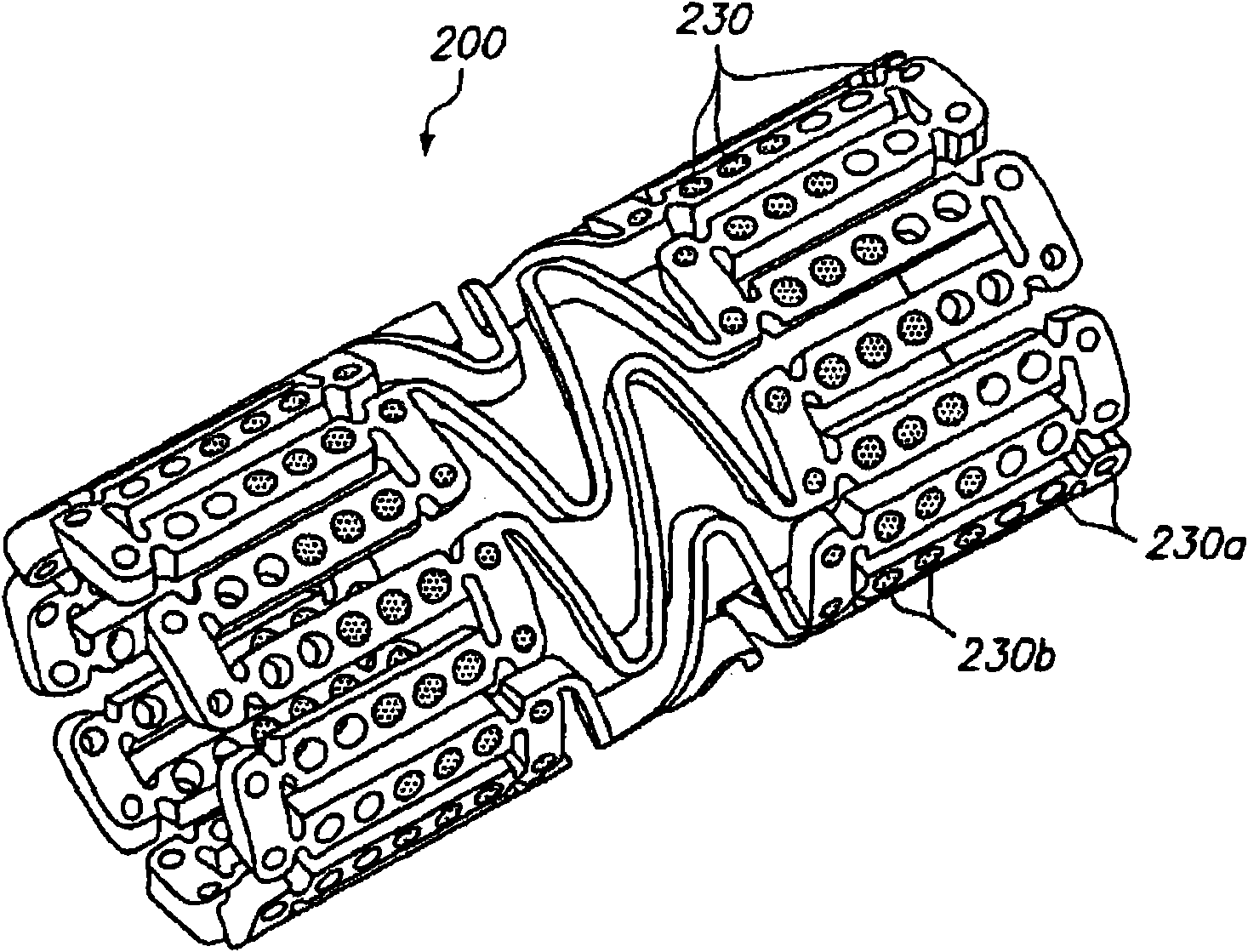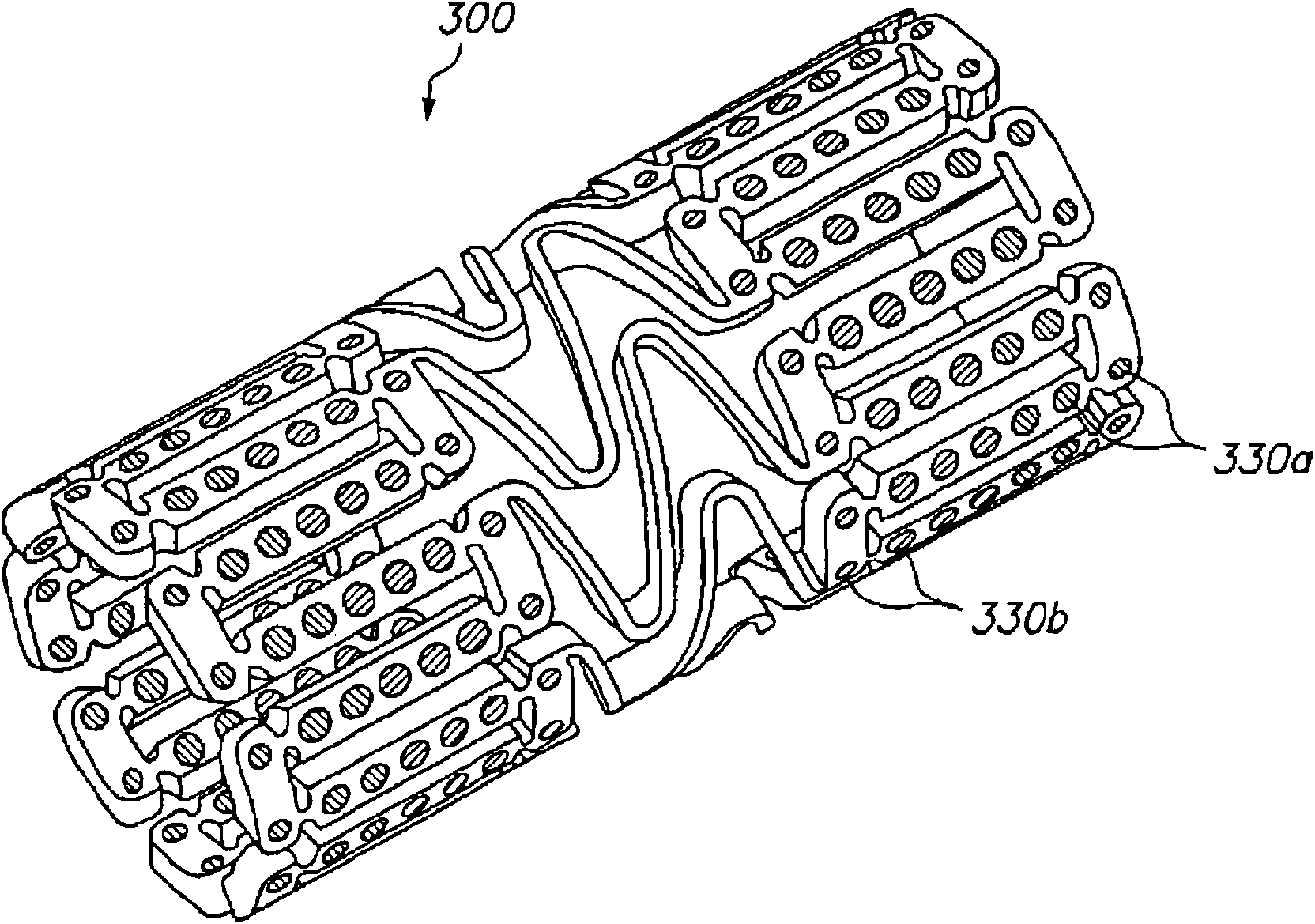Reservoir eluting stent
An internal stent and implantable technology, applied in the direction of stents, dilators, and medical devices, can solve problems such as vascular obstruction and embolism
- Summary
- Abstract
- Description
- Claims
- Application Information
AI Technical Summary
Problems solved by technology
Method used
Image
Examples
example 1
[0075] Figure 7 A dual drug stent 700 is illustrated with an anti-inflammatory agent and an anti-proliferative agent delivered from different orifices of the stent so that the two drugs have independent release kinetics specifically designed to match the biological process of restenosis. According to this example, the dual drug stent comprises a combination of the anti-inflammatory agent pimecrolimus in the first set of openings 710 and the anti-proliferative agent paclitaxel in the second set of openings 720 . Each agent is provided in the matrix material within the pores of the stent in a specific embedded arrangement designed to achieve Figure 8 Release kinetics shown. Each drug is delivered primarily along the lumen wall to treat restenosis.
[0076] Such as Figure 7As shown, pimecrolimus is positioned in the stent for targeted delivery to the luminal side of the stent by using a barrier layer 712 on the luminal side of the pores. The barrier layer 712 is formed of ...
example 2
[0082] According to this example, the dual drug stent contains Gleevec in a first set of openings 710 and the antiproliferative agent paclitaxel in a second set of openings 720 . Each agent is provided in the matrix material within the pores of the stent in a specific embedded arrangement designed to achieve Figure 8 Release kinetics shown.
[0083] Gleevec is delivered with a two-phase release, including an initial high-speed release on the first day followed by a slow release for 1 to 2 weeks. The first phase of Gleevec release is to deliver approximately 50% of the drug load within approximately the first 24 hours. The second phase of release is to deliver the remaining 50% in about 1-2 weeks. Such as Figure 8 As shown in and described in Example 1 above, paclitaxel was loaded into opening 720 in such a way that the resulting release kinetics were substantially linear after about an initial 24 hours.
[0084] Depending on the size of the stent, the amount of drug deli...
example 3
[0086] According to this example, the dual drug stent comprises a combination of PKC-412 (a cell growth regulator) in a first set of openings and the antiproliferative agent paclitaxel in a second set of openings. Each agent is provided in the matrix material within the pores of the stent in a specific embedded arrangement designed to achieve release kinetics as described below.
[0087] PKC-412 is delivered at a substantially constant release rate after about the first 24 hours, over a period of about 4 weeks to 16 weeks, preferably 6 weeks to 12 weeks. Paclitaxel is loaded into the openings in such a way that the resulting release kinetics are substantially linear after about an initial 24 hours, with a release period of about 4 to 16 weeks, preferably about 6 to 12 weeks.
[0088] Depending on the size of the stent, the amount of drug delivered will vary. For a 3 mm x 6 mm scaffold, the amount of PKC-412 is about 100 micrograms to about 400 micrograms, preferably about 150...
PUM
| Property | Measurement | Unit |
|---|---|---|
| diameter | aaaaa | aaaaa |
Abstract
Description
Claims
Application Information
 Login to View More
Login to View More - R&D
- Intellectual Property
- Life Sciences
- Materials
- Tech Scout
- Unparalleled Data Quality
- Higher Quality Content
- 60% Fewer Hallucinations
Browse by: Latest US Patents, China's latest patents, Technical Efficacy Thesaurus, Application Domain, Technology Topic, Popular Technical Reports.
© 2025 PatSnap. All rights reserved.Legal|Privacy policy|Modern Slavery Act Transparency Statement|Sitemap|About US| Contact US: help@patsnap.com



